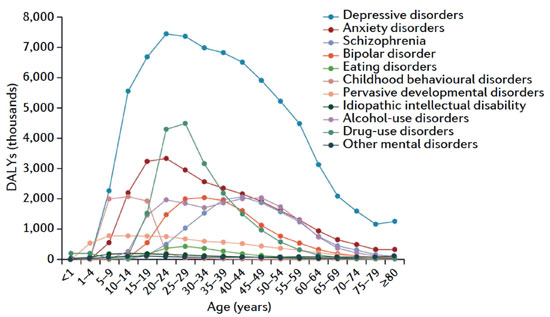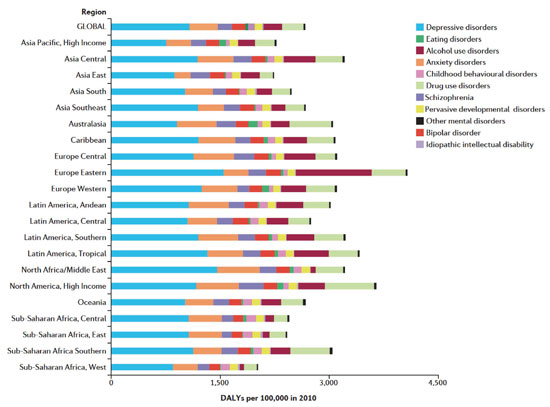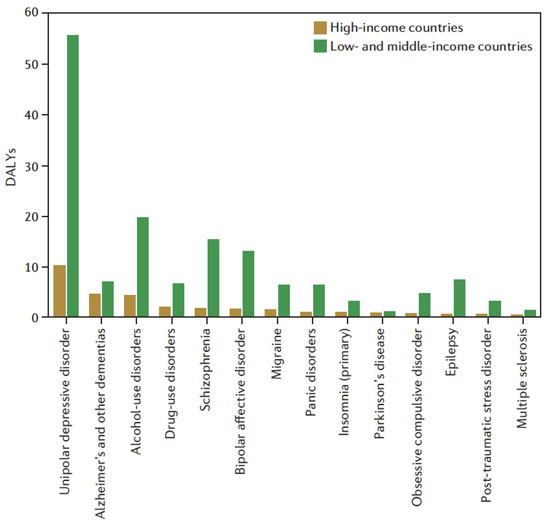NIH-led effort details global brain disorders research agenda in Nature supplement
November / December 2015 | Volume 14, Issue 6
By Ann Puderbaugh
Infants are starved of oxygen during difficult births. Children's cognitive function is permanently damaged due to malnutrition or exposure to infections or toxins. Adults suffer from crippling depression or dementia. The breadth and complexity of these and other brain and nervous system disorders make them some of the most difficult conditions to diagnose and treat, especially in the developing world, where there are few resources. An NIH-led collaboration has studied these complex issues that occur across the lifespan and recently published a supplement to the journal Nature that lays out a research strategy to address them.
The supplement was edited by Dr. Donald Silberberg, of the University of Pennsylvania, Dr. Rajesh Kalaria, of Newcastle University in the U.K. and Dr. Kathy Michels - who manages Fogarty's brain disorders research and training program - as well as Nalini Anand, who heads Fogarty's Center for Global Health Studies.
"We may be at a tipping point for research related to global brain disorders," according to an introductory article authored by the co-editors. "Over the past few decades, exciting basic science discoveries have been made, effective interventions have been developed and advances in technology have set the stage for a research agenda that can lead to unprecedented progress in this field."
More than 40 scientists collaborated to produce nine review articles that detail research priorities for different aspects of brain disorders in low- and middle-income countries (LMICs). The most strategic opportunities involve cross-disciplinary studies of the relationship among environmental, developmental and genetic factors on brain disorders, they note. Advances in genomics provide new clues for mental disorders research, including predispositions for substance abuse and addiction, which could be harnessed to improve diagnosis and identify tailored treatments. The miniaturization of diagnostic technologies and other mobile health advances could improve surveillance, assessment and treatment of mental and nervous system disorders in LMICs, where cellphones are widely used.
To address infection-related nervous system morbidity, the authors say, scientists should produce accurate estimates of disease burden, develop point-of-care assays to diagnose infections, improve tools to assess cognitive and mental health impairment, and study ways to prevent and treat infections. In addition, the authors note LMIC populations suffer exposures to toxins due to poorly regulated mining or other industries, which provide unique opportunities to advance scientific understanding of brain responses to environmental challenges.
The authors also advocate for longitudinal studies that would be conducted across the lifespan in LMICs, to study the unique circumstances and risk factors in childhood, adolescence, adulthood and old age. Regional variations in the challenges posed by brain disorders mean that research priorities need to be addressed country-by-country, and by regions within countries. To explore these many research gaps, local scientific capacity must be developed, as these questions are best addressed by indigenous scientists who can seek context-sensitive solutions, the authors maintain.
Although they cause nearly one-third of the global burden of disease, brain and nervous system disorders have been "largely absent" from the global health agenda, the authors report. As the population ages, these disorders will make up a growing proportion of illness and disability. This rise will be steeper in LMICs, where early life trauma, infectious diseases and malnutrition contribute to the development of these disorders, they predict. Although developing countries bear a disproportionately large share of these problems, they have minimal resources to cope with the challenges.
"This burden significantly affects the ability of children and adolescents to thrive and live out their true potential, and the ability of young adults to be economically productive and support their families, as well as the opportunity for older adults to age in safe and nurturing settings," the co-authors observe.
The tide is starting to change, the supplement's authors acknowledge, with mental health, substance abuse and chemical exposures among the priorities included in the new Sustainable Development Goals, announced by the U.N. last September.
The project, led by Fogarty's Center for Global Health Studies, grew from a meeting of grantees and other scientific experts, convened in February 2014.
While advances in brain imaging, nanoscience and genetics hold much promise for research discoveries, more resources are needed, according to Fogarty Director Dr. Roger I. Glass, who contributed a foreword to the publication. "We hope this supplement inspires other scientists and funding partners to join us in addressing the full spectrum of research, training, implementation and policy questions needed to alleviate global suffering from mental and neurological disorders that occur across the lifespan."
More Information
Related Graphs
The following graphs accompanied the Nature supplement Brain disorders across the lifespan: Research to achieve nervous system health worldwide, published online November 19, 2015.
Graph 1: Disability-Adjusted Life Years (DALYs) for each brain disorder by age

Note the rise of NMS disorders in late childhood and adolescence, particularly depression, anxiety, alcohol and other drug-use disorders.
Graph 1 data source: Global burden of disease attributable to mental and substance use disorders: findings from the Global Burden of Disease Study 2010, The Lancet, November 9, 2013.
Graph 1 related article: A focus on adolescence to reduce neurological, mental health and substance-use disability
Nature supplement, November 19, 2015 (online)
Graph 2: Burden of risk associated with specific brain disorders

Graph 2 data source: Global Burden of Disease Study 2010
Graph 2 related article: Global research challenges and opportunities for mental health and substance-use disorders
Nature supplement, November 19, 2015 (online)
Graph 3: Comparison of DALYs

Graph 3 data source: Global Burden of Disease Study 2010 and World Health Organization Metrics: Disability-Adjusted Life Year (DALY)
Graph 3 related article: Regional research priorities in brain and nervous system disorders
Nature supplement, November 19, 2015 (online)
To view Adobe PDF files,
download current, free accessible plug-ins from Adobe's website.